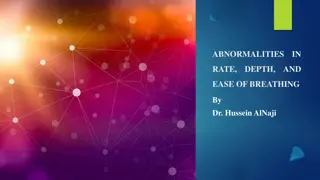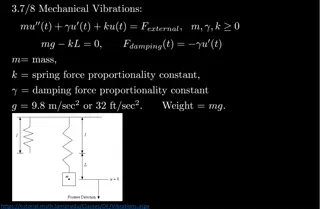StudyMafia.org - Understanding Dyspnea Symptoms and Causes
Dyspnea, commonly known as shortness of breath, can be a sign of underlying health issues. Learn about the symptoms, causes, diagnosis, and treatment options for dyspnea in this informative guide.
Uploaded on Apr 19, 2025 | 2 Views
Download Presentation

Please find below an Image/Link to download the presentation.
The content on the website is provided AS IS for your information and personal use only. It may not be sold, licensed, or shared on other websites without obtaining consent from the author.If you encounter any issues during the download, it is possible that the publisher has removed the file from their server.
You are allowed to download the files provided on this website for personal or commercial use, subject to the condition that they are used lawfully. All files are the property of their respective owners.
The content on the website is provided AS IS for your information and personal use only. It may not be sold, licensed, or shared on other websites without obtaining consent from the author.
E N D
Presentation Transcript
StudyMafia.Org Dyspnea Submitted Studymafia.org Studymafia.org Submitted To: To: Submitted Submitted By: By: Studymafia.org Studymafia.org
Table Contents Definition Introduction Symptoms of Dyspnea Causes of Dyspnea Diagnosis of Dyspnea Treatment of Dyspnea Prevention of Dyspnea Conclusion 2
Definition Dyspnea, which some refer to as shortness of breath, is a feeling that you cannot breathe enough air into your lungs. 3
Introduction During this, you may also experience tightness in your chest. This shortness of breath can be a symptom of health conditions, often relating to heart or lung disease. However, you can also experience temporary dyspnea after an intense workout or other physical activity. Read on to learn more about the symptoms of dyspnea, its causes, and how doctors can treat it. 4
Symptoms of Dyspnea The main symptom of dyspnea is labored breathing. It may last for 1 or 2 minutes after strenuous activity. Or it could be a chronic symptom that persists over longer periods, according to the National Health Service. In mild cases, you may feel like you are not getting quite enough air into your lungs. 6
Symptoms of Dyspnea You re short of breath sooner than you used to be after physical activity. You re breathless after activity that you used to handle without a problem. You start to experience dyspnea without any explanation. 7
Causes of Dyspnea Exercise is usually a trigger for short-term dyspnea. Following strenuous activity, you may have trouble taking in enough oxygen to meet your body s demands. In these cases, it is natural to need a few minutes to catch your breath. However, this will typically improve with rest, and you ll be breathing at your regular rate within a few minutes. 8
Causes of Dyspnea If you re at a higher elevation and you re not used to having less oxygen available, you may also experience temporary dyspnea. Be sure to consult with a climbing expert before making an ambitious high-elevation trek. Dyspnea can also result from a wide range of health conditions. 9
Causes of Dyspnea Conditions that may cause short-term dyspnea include: sudden heart failure low blood pressure pneumonia pulmonary embolism (a blood clot in the lungs) pneumothorax (collapsed lung) carbon monoxide poisoning 10
Causes of Dyspnea anaphylaxis (severe allergic reaction) stress or anxiety extreme temperatures pleural effusion worsening chronic obstructive pulmonary disease (COPD) You may also experience sudden dyspnea if a piece of food or some other object blocks your airway. 11
Causes of Dyspnea Examples of chronic dyspnea causes include: chronic COPD, which covers emphysema and chronic bronchitis interstitial lung disease (scarring of lung tissue) difficulty managing your physical conditioning lung cancer pulmonary hypertension obesity 12
Causes of Dyspnea Asthma can be both a chronic condition and a short-term emergency. This can depend on the nature of your condition and the availability of an inhaler during sudden attacks. If you have asthma, talk with your doctor about how to respond to symptoms and what you can do to prevent breathing concerns. 13
Diagnosis of Dyspnea Doctors will first assessTrusted Source your airways, breathing, and circulation to determine if you require immediate emergency care. These may include: physical evaluation a review of medical history imaging scans blood tests lung function tests (spirometry) pulse oximetry 14
Diagnosis of Dyspnea Doctors may also use computerized tomography (CT) scans during diagnosis. These scans can show: pneumonia pulmonary embolism pleural effusions tumors interstitial lung disease 15
Treatment of Dyspnea Diet and exercise If having obesity and having a difficult time managing your fitness level are causing dyspnea, eating a balanced diet and frequently exercising may help reduce symptoms. 16
Treatment of Dyspnea Pulmonary rehabilitation COPD and other lung conditions require the care of a pulmonologist, a doctor who specializes in the health of your lungs and respiratory system. You may need supplemental oxygen in a portable tank to help keep you from feeling out of breath. 17
Treatment of Dyspnea Cardiac rehabilitation Dyspnea is one of several symptoms of heart failure. If you have heart failure, it means your heart is too weak to pump enough oxygenated blood to meet your body s requirements. 18
Prevention of Dyspnea Treating underlying conditions. Underlying health conditions can cause dyspnea. Sticking to treatment plans in order to manage these can help to prevent shortness of breath. Avoiding air pollution. Air pollution and airborne chemicals can also lead to breathing concerns. 19
Prevention of Dyspnea Maintaining a moderate weight. This can help you avoid a number of health concerns. Avoiding overexertion. Intense physical activity can cause short-term dyspnea. Avoiding, or minimizing, overexertion can help prevent this from occurring. 20
Conclusion Because dyspnea is a symptom, not a condition, your outlook will depend on how well you can manage or avoid its causes. Conditions such as COPD and heart failure are chronic, meaning you will have them for life. However, improvements in treatment are helping people live longer and with a greater quality of life, even with these conditions. 22





